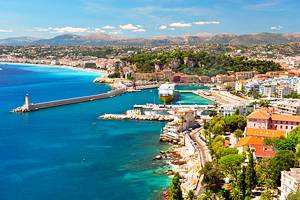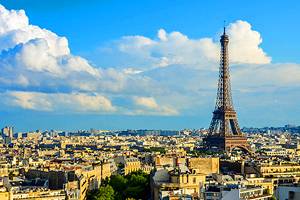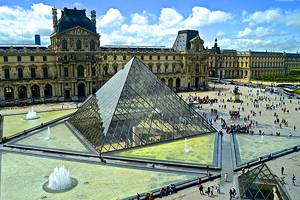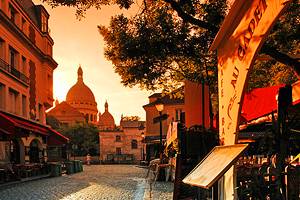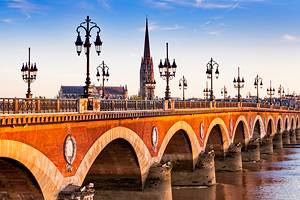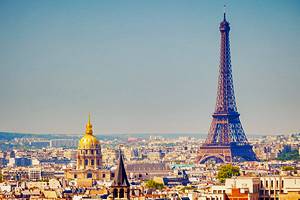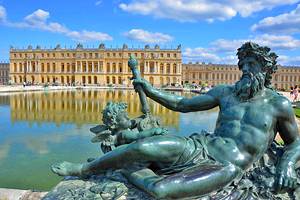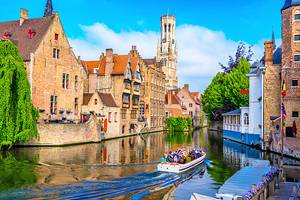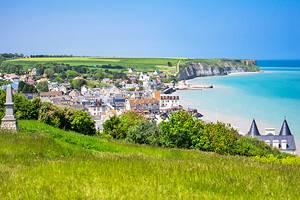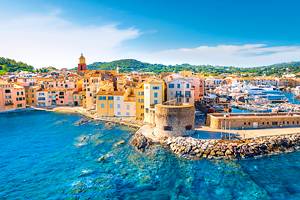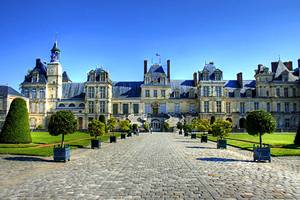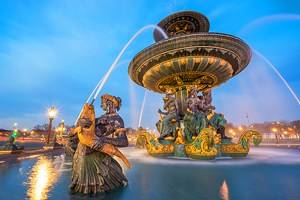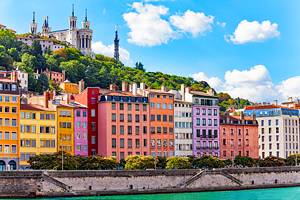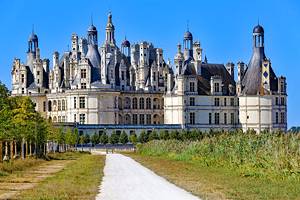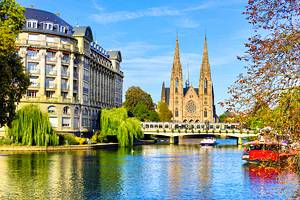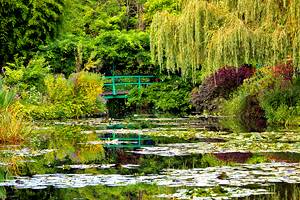Tourist Attractions in Reims
Set your imagination back in time to pre-Revolution France, when French kings were coronated at the Cathédrale Notre-Dame de Reims. The spacious Place du Cardinal Luçon facing the cathedral provided room for jubilant crowds to gather and greet the king after his anointment ceremony within the high-vaulted sanctuary.

Thanks to this heritage, Reims is listed as one of the country's Villes d'Art et d'Histoire (Cities of Art and History) and ranks among the top tourist destinations in the Champagne region.
A world of cultural discoveries awaits you in Reims. While wandering the city's tree-lined streets and cobblestone lanes, you will come across impressive landmarks and elegant public squares.
In between sightseeing, you may stop at one of the city's many stylish restaurants. Reims boasts three UNESCO World Heritage Sites and four Michelin-starred dining rooms.
There's plenty to see on a quick day trip from Paris (less than one hour away by TGV train) and enough to keep you entertained for a longer stay.
Although Reims was damaged during the First and Second World Wars, the town has been marvelously rebuilt, and many of the newer buildings were designed in a lovely Art Deco style.
Discover interesting places to visit and things to do in Reims with our list of the top attractions.
- Cathédrale Notre-Dame de Reims
- Palais du Tau (Archbishops' Palace)
- Basilique Saint-Rémi
- Elegant Public Squares & Ancient Monuments
- Musée des Beaux-Arts
- Musée Saint-Rémi
- Musée Hôtel Le Vergeur
- Chapelle Foujita (Chapelle Notre-Dame-de-la-Paix)
- Festivals
- Musée de la Reddition (World War II Museum)
- Map of Attractions & Things to Do in Reims
Cathédrale Notre-Dame de Reims

The Cathedral of Notre-Dame stands proudly in the center of Reims with its soaring towers visible from a distance. One of France's finest cathedrals, this UNESCO World Heritage Site is considered a masterpiece of Gothic architecture.
The magnificent 13th-century edifice features a richly adorned facade resembling lacework, and boasts over 2,000 statues. Three ornate doorways grace the west front of the cathedral, with a rose window over the central doorway. Above this is the iconic Gallery of Kings, a long row of statues set in niches. The sculpture on the central doorway depicts the life of the Virgin.
One amusing feature of the facade is the Sourire de Reims (Smiling Angel) statue.
Upon entering the sanctuary, you will be dazzled by the enormity of the space. The vast nave has an ambience of solemnity and yet a surprising luminous quality, as it is illuminated by an abundance of stained-glass windows. Three stained-glass windows by Marc Chagall and nine by the German artist Imi Knoebel have added a modern touch to the cathedral.

Reims' cathedral enjoys a very special position in French history. Similar to Westminster Abbey in London, the Cathédrale Notre-Dame de Reims was used for the monarchy's coronation ceremonies (for more than eight centuries).
Joan of Arc accompanied Charles VII here in July of 1429 for his coronation. She appears in an equestrian statue on the square in front of the cathedral.
Today, the Cathédrale Notre-Dame de Reims is open year-round daily, from 7:30am until 7:30pm. You may visit independently or take a guided tour (available in English). Access is also allowed to the cathedral towers.
Address: Place du Cardinal Luçon, Reims
Read More: Places to Visit in France

Palais du Tau (Archbishops' Palace)

Note: The Palais du Tau is currently undergoing renovations and will be closed until 2025.
Discover the majestic accommodations where the kings of France resided in Reims during coronation ceremonies. In these splendid surroundings, it's easy to imagine the grandeur of past royal events.
Adjoining the cathedral, the UNESCO-listed Palais du Tau reveals the French Neoclassical style of the 17th century. However, the building dates to a much earlier period and has several perfectly preserved medieval rooms.
The Salle de Tau, the banquet hall used after coronation ceremonies, is adorned with exquisite 15th-century Arras tapestries. These tapestries present the story of the legendary King Clovis.
Within the palace's 13th-century Chapelle Palatine, a treasury contains remarkable items, including the 9th-century talisman of Charlemagne and the 12th-century chalice of Saint Rémi.
Address: 2 Place du Cardinal Luçon, Reims
Basilique Saint-Rémi

The oldest church in Reims, the Basilique Saint-Rémi is an exceptional Romanesque monument and is listed as a UNESCO World Heritage Site. The church was built between 1005 and 1049 (for a Benedictine abbey) on the site of an 8th-century Carolingian chapel, which drew many pilgrims.
Although the exterior is Gothic, the interior still has elements of the original Romanesque structure. The harmonious 11th-century nave is illuminated by 12th-century stained-glass windows, giving the sanctuary a warm and ethereal ambience, while the choir and surrounding chapels exemplify a serene Early Gothic style.
The church houses the tomb of Saint Rémi (440-533), which has made this basilica a place of veneration since the 8th century.
During the Hundred Years' War, the abbey fell into decline and was later revived during the Renaissance. During the French Revolution, the monks were expelled, and the basilica was converted into a parish church. The First World War caused damage to the building, which took forty years to repair.
Today, the Basilique Saint-Rémi is open year-round daily, except on Sunday mornings. Occasionally the church is used as a venue for music concerts.
Address: Place Chanoine Ladame, Reims
Elegant Public Squares & Ancient Monuments

Most likely, the first square you will see in Reims city center is the Place Cardinal Luçon, where the cathedral, the Palais de Justice (Law Courts), and a bronze Joan of Arc statue are located.
Also a must-see attraction, the expansive Place de la République boasts a well-manicured park space and an imposing 3rd-century Roman triumphal arch, the Porte de Mars, which served as a town gate until 1544.
South of the Place de la République is the Hôtel de Ville (Town Hall), constructed between 1627 and 1630.
Another well-preserved 3rd-century Roman monument is the Cryptoportique, found at the Place du Forum. This archaeological site is used as a venue for summertime music concerts.
A happening area of Reims is the Place Drouet d'Erlon, a pleasant tree-lined square with many bustling brasseries and restaurants. Dining at an outdoor terrace on this square is one of the most enjoyable things to do in Reims.
At the southern end of the Place Drouet d'Erlon stands the second oldest church in Reims, the Eglise Saint-Jacques, which dates from the 12th to 16th centuries.
The most elegant square in Reims is the Place Royale lined with handsome Neoclassical buildings. A bronze statue of King Louis XV stands at the center of the square.
Musée des Beaux-Arts

Note: The Musée des Beaux-Arts is currently closed due to a renovation project. The museum is expected to reopen in 2025.
Reims has an excellent fine arts museum, as you would expect from a Ville d'Art et d'Histoire. The museum contains masterpieces of French and European paintings, from the Renaissance period until the Art Déco movement of the modern era.
Highlights at the Musée des Beaux-Arts include religious art; 19th-century landscape paintings (including many pieces by Camille Corot); and Impressionist paintings by famous artists such as Monet, Renoir, and Pissarro.
Address: 8 Rue Chanzy, Reims
Musée Saint-Rémi

Listed as a UNESCO World Heritage Site, the former Saint-Rémi Royal Abbey is a gem of Neoclassical architecture. This building had an important purpose: guarding the Holy Ampulla (sacred ointment) that was used to anoint kings during coronation ceremonies.
The Saint-Rémi Royal Abbey building now houses the Musée Saint-Rémi, with collections devoted to local history until the Renaissance era; the history of the abbey's buildings; the military history of France, from ancient times until the 19th century; and Gallo-Roman antiquities from the ancient city of Durocortorum (present-day Reims).
This museum is one of the best places to visit to learn about the history of Reims. The museum is open year-round daily, except Mondays. Museum hours are 10am until 6pm.
Address: 53 Rue Simon, Reims
Musée Hôtel Le Vergeur

The Musée Hôtel Le Vergeur displays a unique collection in a hôtel particulier (mansion), listed as a Monument Historique. The Hôtel Le Vergeur takes its name from the wealthy Vergeur family who owned the house until the 16th century.
The most recent owner of the Hôtel Le Vergeur, Hugues Krafft, devoted much of his fortune to restoring the house. He decorated the rooms with splendid furniture and created an art collection consisting of objects brought back from his many trips abroad.
Today, the museum displays Krafft's decorative arts collection, as well as an eclectic assortment of prints and paintings that illustrate the history of Reims; objects that were part of royal coronations; and exceptional pieces of religious art, most notably the engravings by Albrecht Dürer.
The museum is open year-round daily, except Mondays and national holidays (January 1st, May 1st, November 1st, and December 25th). Hours are from 10am until 12 noon and 2pm until 6pm.
Address: 36 Place du Forum, Reims
Chapelle Foujita (Chapelle Notre-Dame-de-la-Paix)

The Japanese artist of the Ecole de Paris, Tsuguharu Foujita was so inspired by a visit to the Basilique Saint-Rémi that he decided to convert to Christianity. His baptism took place on October 14, 1959 at the Cathédrale Notre-Dame de Reims, and he received the baptismal name, Léonard.
In 1965, with a single-minded artistic vision, Leonard Foujita built his very own chapel in Reims. The Chapelle Foujita was designed entirely by Foujita, from start to finish. He oversaw the architectural plans, designed the sketches for the ironwork and stained-glass windows, and next he painted the frescoes in the chapel's choir.
Foujita chose the Romanesque style for the chapel because it recalls the Saint-Rémi Basilica and because its simple structure would be ideal for displaying his artistic creation. Foujita's sense of spirituality shines in each scene of his monumental work adorning the chapel.
Listed as a Monument Historique, the Chapelle Foujita is open to the public as a museum. You may visit from May through September every day except Tuesdays. Hours are 10am until 12pm and 2pm until 6pm.
Address: 33 Rue du Champ de Mars, Reims
Festivals

Every year in spring or early summer (dates vary), Reims transforms itself into the scene of a medieval celebration for Les Fêtes Johanniques, the Joan of Arc Festival. The two-day festival reenacts the Saint's arrival in Reims for the coronation of King Charles VII at the Cathédrale Notre-Dame de Reims.
Les Fêtes Johanniques commemorates this pivotal event in French history (which took place on July 17, 1429) with musical and dance performances, artisans' ateliers (such as calligraphy and weaving workshops), falcon presentations, and street theater. Town residents dress up in period costumes to follow "Joan of Arc" and "King Charles VII" in a Grand Coronation procession to the Notre-Dame Cathedral.
Another lively cultural event is Les Sacres du Folklore, which brings together folk singers, musicians, and dancers from across the globe. The festival takes place for several days in June or July and features dance performances, music concerts, and a gala event.
Musée de la Reddition (World War II Museum)

The Musée de la Reddition (Museum of the Surrender) is dedicated to the remembrance of the Second World War. The museum occupies a Monument Historique, the building where General Eisenhower's headquarters were located during the war.
Most importantly, this building is where the German General Jodl announced the surrender of the Third Reich's armed forces on May 7, 1945, ending the war. The news was then announced simultaneously in the Allied capitals on May 8, 1945.
Exhibits show the role of Reims during the Second World War. From Occupation to Liberation, the story of the war is told through objects, documents, memorabilia, and models. The museum also presents interesting information about the French Resistance.
The museum is open year-round daily, from 10am until 6pm.
Address: 12 Rue Franklin Roosevelt, Reims
Map of Attractions & Things to Do in Reims
More Related Articles on PlanetWare.com
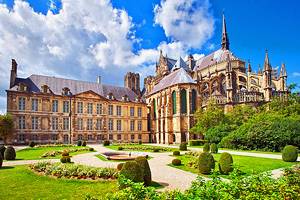
The Champagne and Lorraine Regions: Reims is nestled in the beautiful Champagne region, a landscape of woodlands, valleys, and rolling vine-covered hills. Besides its gorgeous pastoral scenery, the area is full of historic treasures, such as medieval towns and ancient castles.
Neighboring the Champagne region, the Lorraine region is appreciated for its pristine countryside, especially the Vosges Mountains' forested hills and alpine lakes, as well as for its cultured cities. The "City of Art and History," Metz (a two-hour drive away) is the closest urban center to Reims in the Lorraine region. Renowned for its refined Baroque architecture, the elegant town of Nancy is about a 2.5-hour drive away from Reims or just a two-hour ride on the TGV train.
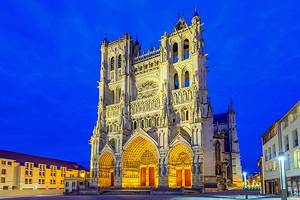
Cultured Towns in Northern France: Many vibrant cities and atmospheric towns are found north of Reims. At the top of most tourist itineraries is Paris, about a 90-minute drive or 45-minute TGV train ride from Reims. In the historic Picardy region, charming and cultured Amiens (less than a two-hour drive away) delights visitors with its impressive monuments and trendy medieval quarter.
Farther north, the Nord-Pas-de-Calais region is dotted with quaint villages and typical Flemish towns, such as Arras (about a two-hour drive). A tour of Flemish Baroque architecture continues in Lille (two hours away by train or car), the most important metropolis in French Flanders. Travelers will enjoy discovering the city's appealing old-world character, as well as its exceptional fine arts museums.



